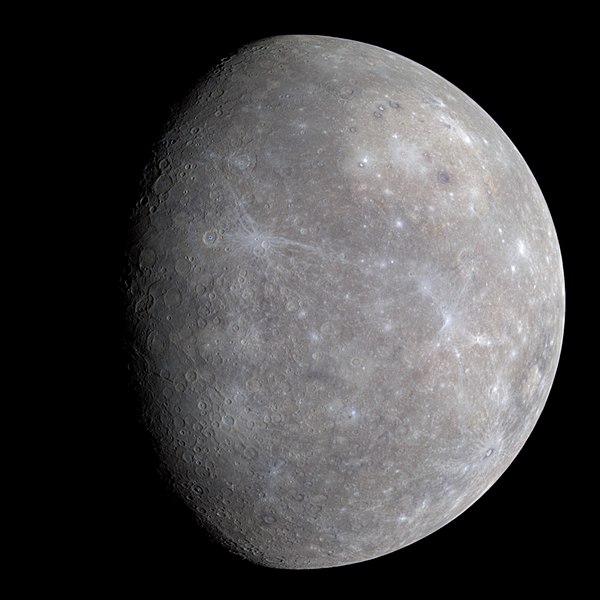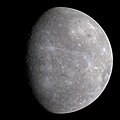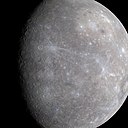
Original file (1,950 × 1,950 pixels, file size: 734 KB, MIME type: image/jpeg)
This file is from Wikimedia Commons and may be used by other projects. The description on its file description page there is shown below.
|
Summary
| DescriptionMercury in color - Prockter07-edit1.jpg |
العربية: صُورة بِألوانٍ مُحسَّنة لِكوكب عُطارد التقطها مسبار مسنجر خِلال عُبُوره الأوَّل بالقُرب من الكوكب المذكور.
Original caption: Color differences on Mercury are subtle, but they reveal important information about the nature of the planet's surface material. A number of bright spots with a bluish tinge are visible in this image. These are relatively recent impact craters. Some of the bright craters have bright streaks (called "rays" by planetary scientists) emanating from them. Bright features such as these are caused by the presence of freshly crushed rock material that was excavated and deposited during the highly energetic collision of a meteoroid with Mercury to form an impact crater. The large circular light-colored area in the upper right of the image is the interior of the Caloris basin. Mariner 10 viewed only the eastern (right) portion of this enormous impact basin, under lighting conditions that emphasized shadows and elevation differences rather than brightness and color differences. MESSENGER has revealed that Caloris is filled with smooth plains that are brighter than the surrounding terrain, hinting at a compositional contrast between these geologic units. The interior of Caloris also harbors several unusual dark-rimmed craters, which are visible in this image. The MESSENGER science team is working with the 11-color images in order to gain a better understanding of what minerals are present in these rocks of Mercury's crust. The diameter of Mercury is about 4880 kilometers (3030 miles). The image spatial resolution is about 2.5 kilometers per pixel (1.6 miles/pixel). The WAC departure mosaic sequence was executed by the spacecraft from approximately 19:45 to 19:56 UTC on January 14, 2008, when the spacecraft was moving from a distance of roughly 12,800 to 16,700 km (7954 to 10377 miles) from the surface of Mercury. |
||||||
| Date | |||||||
| Source |
NASA. |
||||||
| Author | National Aeronautics and Space Administration/Johns Hopkins University Applied Physics Laboratory/Carnegie Institution of Washington | ||||||
| Other versions |
|
Licensing
| Public domainPublic domainfalsefalse |
| This file is in the public domain in the United States because it was solely created by NASA. NASA copyright policy states that "NASA material is not protected by copyright unless noted". (See Template:PD-USGov, NASA copyright policy page or JPL Image Use Policy.) |  | |
 |
Warnings:
|
Original upload log
This image is a derivative work of the following images:
- Image:Mercury_in_color_-_Prockter07.jpg licensed with PD-USGov-NASA, PD-USGov-NASA/copyright
- 2008-02-18T06:16:52Z Superm401 3000x2025 (1325745 Bytes) Reverted to version as of 01:42, 31 January 2008
- 2008-01-31T01:52:50Z Kwamikagami 2072x2025 (1091977 Bytes)
- 2008-01-31T01:42:24Z Kwamikagami 3000x2025 (1325745 Bytes) {{Information |Description=Full color image of Mercury from first MESSENGER flyby |Source=NASA/APL |Date=2008 Jan 30 |Author=NASA |Permission=public |other_versions=color version of [[Image:MESSENGER first photo of unseen sid
Uploaded with derivativeFX
Captions
30 January 2008
image/jpeg
File history
Click on a date/time to view the file as it appeared at that time.
| Date/Time | Thumbnail | Dimensions | User | Comment | |
|---|---|---|---|---|---|
| current | 15:12, 3 June 2008 |  | 1,950 × 1,950 (734 KB) | wikimediacommons>Jjron | {{Information |Description={{Information |Description=Full color image of from first MESSENGER flyby |Source=NASA/JPL [http://messenger.jhuapl.edu/gallery/sciencePhotos/image.php?page=1&gallery_id=2&image_id=143] |Date=2008-01-30 |Author=NASA/[ |
File usage
There are no pages that use this file.
Global file usage
The following other wikis use this file:
- Usage on bapham123.miraheze.org
- Usage on miraheze.org
- Usage on miraheze.org
- Usage on zhdel.miraheze.org
Metadata
This file contains additional information, probably added from the digital camera or scanner used to create or digitize it.
If the file has been modified from its original state, some details may not fully reflect the modified file.
| Orientation | Normal |
|---|---|
| Horizontal resolution | 300 dpi |
| Vertical resolution | 300 dpi |
| Software used | Adobe Photoshop CS Windows |
| File change date and time | 00:58, 4 June 2008 |
| Color space | sRGB |


